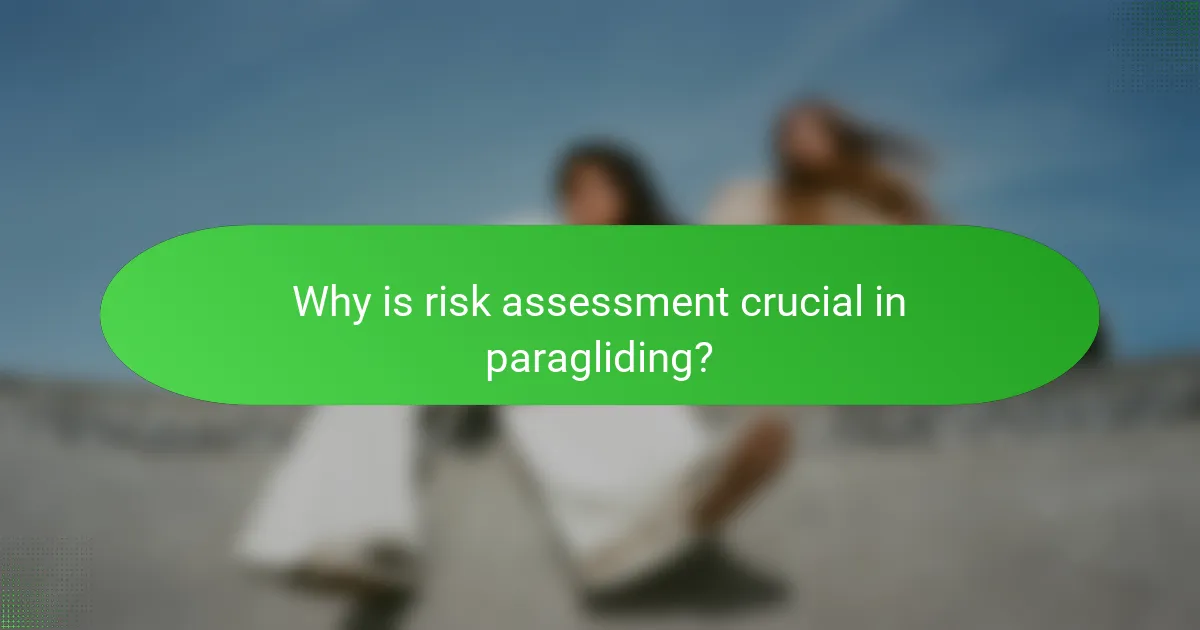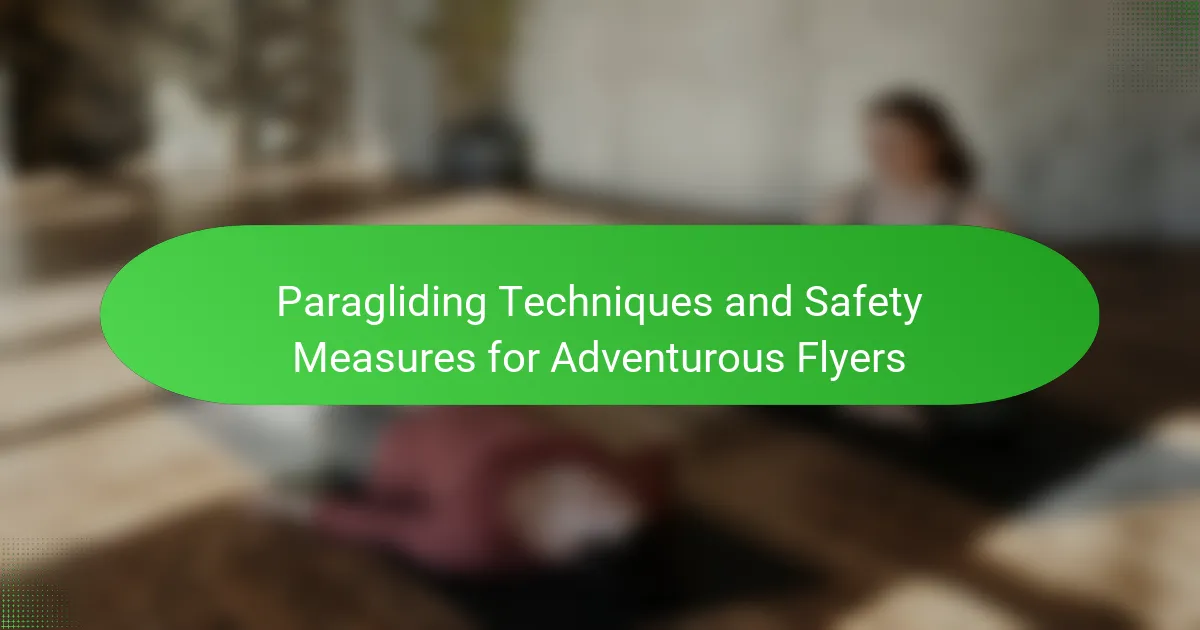Paragliding offers thrilling experiences, but mastering techniques and safety measures is essential for a secure flight. Learn essential skills like launching, controlling the wing, and landing safely. Explore advanced maneuvers, risk assessment strategies, and the importance of safety equipment. Understand local regulations and best practices to enhance your paragliding adventures.

What are the essential paragliding techniques for beginners?
Essential paragliding techniques for beginners include mastering launching, controlling the wing, and landing safely. Focus on smooth takeoffs by using proper body posture and weight shifting. Learn to manage the wing’s angle of attack for stable flight. Landing requires practice in flare timing and approach control to ensure a safe touchdown. Understanding wind conditions and practicing emergency procedures enhances overall safety and confidence.
How does wing control impact flight stability?
Wing control significantly enhances flight stability in paragliding by allowing pilots to manage airflow and balance. Proper wing control minimizes turbulence effects and maintains optimal lift, ensuring a smoother flight experience. Techniques such as weight shifting and brake input are essential for effective wing management. Mastery of these techniques can reduce the risk of accidents and improve overall safety during flights.
Which launch techniques are most effective for different terrains?
Different terrains require specific paragliding launch techniques for optimal safety and performance. For flat ground, a forward launch is effective, while slopes benefit from a reverse launch. In mountainous areas, a dynamic launch is essential to utilise wind currents. Each technique adapts to terrain conditions, enhancing safety and flight success.
What is the importance of thermals in paragliding?
Thermals are crucial in paragliding as they provide lift, allowing pilots to gain altitude without engine power. Understanding thermals enhances flight duration and control. Mastery of thermal flying leads to safer and more efficient navigation. Pilots can exploit rising air currents to extend their glides, making thermals essential for long-distance flights.

How can experienced flyers enhance their paragliding skills?
Experienced flyers can enhance their paragliding skills through practice, advanced techniques, and safety measures. Focus on mastering dynamic control, understanding weather patterns, and refining landing approaches.
1. Practice regularly to build muscle memory and confidence.
2. Learn advanced maneuvers like wing overs and spirals for better control.
3. Analyse weather conditions to make informed decisions.
4. Refine landing techniques to ensure safe and accurate landings.
5. Engage in cross-training activities such as mountain biking or hiking to improve overall fitness and agility.
By integrating these strategies, seasoned paragliders can elevate their skills and safety awareness.
What advanced maneuvers can improve performance?
Advanced maneuvers such as dynamic soaring, wingovers, and spiral descents can significantly enhance paragliding performance. These techniques improve speed, control, and maneuverability.
Dynamic soaring allows pilots to gain altitude by exploiting wind gradients. Wingovers enhance turning ability, providing tighter control during flight. Spiral descents enable rapid altitude loss while maintaining stability. Mastering these techniques requires practice and understanding of weather conditions.
Which techniques help in navigating adverse weather conditions?
To navigate adverse weather conditions in paragliding, pilots should utilise specific techniques. Understanding wind patterns is essential for safe takeoffs and landings. Using weather apps can provide real-time updates. Adjusting flight plans based on changing conditions enhances safety. Practicing emergency maneuvers prepares pilots for unexpected turbulence. Regularly checking equipment ensures reliability during challenging weather.

What safety measures should every paraglider follow?
Every paraglider should follow essential safety measures to ensure a safe flying experience. First, conduct thorough pre-flight checks on equipment, including the paraglider, harness, and reserve parachute. Next, assess weather conditions, avoiding flying in strong winds or storms. Always fly with a buddy for enhanced safety and communication. Use proper launching and landing techniques to prevent accidents. Lastly, stay informed about local regulations and airspace restrictions.
How can pre-flight checks prevent accidents?
Pre-flight checks significantly reduce the risk of accidents in paragliding. These checks ensure that equipment functions properly, weather conditions are suitable, and the pilot is prepared. Regular inspections of the wing, harness, and lines help identify potential issues that could lead to failure during flight. A thorough pre-flight routine enhances overall safety and builds pilot confidence.
What role does equipment maintenance play in safety?
Equipment maintenance is crucial for ensuring safety in paragliding. Regular checks and repairs prevent equipment failure, which can lead to serious accidents. Properly maintained gear enhances performance and reliability during flights. For instance, inspecting lines, harnesses, and canopies minimises risks associated with wear and tear. A well-maintained paraglider significantly reduces the likelihood of malfunctions, ensuring a safer experience for adventurous flyers.

Why is risk assessment crucial in paragliding?
Risk assessment is crucial in paragliding because it identifies potential hazards and enhances safety measures. By evaluating environmental conditions, equipment reliability, and pilot skill levels, flyers can make informed decisions. This proactive approach reduces accidents and ensures a safer flying experience. Proper risk assessment involves analysing factors like weather patterns, site conditions, and personal limitations. As a result, paragliders can optimise their techniques and improve overall safety, making the sport more enjoyable and secure.
How do environmental factors affect safety?
Environmental factors significantly impact paragliding safety by influencing conditions like wind patterns, visibility, and terrain. Wind strength and direction can affect launch and landing stability, while poor visibility can hinder navigation. Additionally, varying terrain can create unexpected hazards. Understanding these factors is crucial for safe paragliding.
What are the common risks associated with paragliding?
Paragliding carries several common risks that adventurous flyers should be aware of. These include equipment failure, weather changes, and pilot error. Equipment failure can lead to serious accidents if gear is not properly maintained. Sudden weather changes, such as strong winds or turbulence, can create dangerous flying conditions. Pilot error, often due to inexperience or poor decision-making, is a significant factor in many incidents. Understanding and mitigating these risks through proper training and safety measures is essential for a safe paragliding experience.

What unique safety equipment enhances paragliding experiences?
Unique safety equipment that enhances paragliding experiences includes advanced helmets, reserve parachutes, and GPS tracking devices. These tools significantly improve safety and performance for adventurous flyers. Advanced helmets provide head protection and communication capabilities. Reserve parachutes offer an essential backup for emergencies. GPS tracking devices enhance navigation and allow for real-time location sharing, increasing safety during flights. Together, these unique safety features contribute to a more secure and enjoyable paragliding experience.
How do parachute reserves function in emergencies?
Parachute reserves function as a critical safety feature in emergencies, providing an alternative for safe landing. When a pilot experiences a malfunction with the main parachute, deploying the reserve parachute allows for controlled descent and reduces the risk of injury.
The reserve parachute is typically packed in a container separate from the main parachute, ensuring quick access. It is designed to open quickly and reliably, often featuring a different design that enhances stability and descent rate. Regular checks and maintenance of the reserve system are essential to ensure its functionality during emergencies.
In summary, reserve parachutes are vital for ensuring safety in paragliding, enabling pilots to respond effectively to unexpected situations.
What innovations in gear are improving safety standards?
Innovations in gear are enhancing safety standards in paragliding through advanced materials, improved design, and integrated technology. New parachute fabrics increase durability while reducing weight, allowing for better performance. Smart helmets with built-in communication systems enhance pilot awareness and coordination. Additionally, automatic deployment systems are being developed to ensure parachutes open in emergencies, significantly increasing safety. These advancements are crucial for both novice and experienced flyers, fostering a safer paragliding experience.

Which regulatory guidelines must paragliders adhere to?
Paragliders must adhere to regulatory guidelines set by aviation authorities, which vary by country. These guidelines typically include obtaining proper licensing, following designated flight paths, and ensuring equipment meets safety standards. Compliance with local airspace regulations is essential for safe flying. Paragliders should also participate in safety training and maintain awareness of weather conditions.
How do local laws impact paragliding activities?
Local laws significantly influence paragliding activities by regulating where and how these sports can be practised. Compliance with airspace regulations, safety standards, and land use laws is crucial for safety and legality.
For example, some regions require paragliders to obtain permits or adhere to specific flight paths to avoid conflicts with other air traffic. Additionally, local laws may restrict paragliding in certain areas due to environmental concerns or wildlife protection.
Understanding these regulations helps adventurous flyers plan their activities safely and legally, ensuring a positive experience while respecting local guidelines.
What are the best practices for responsible paragliding?
The best practices for responsible paragliding include thorough pre-flight checks, understanding weather conditions, and using appropriate gear. Prioritise safety by ensuring your equipment is well-maintained and suited for your skill level.
1. Conduct a pre-flight inspection to confirm the integrity of the wing, harness, and other gear.
2. Assess weather conditions to avoid flying in strong winds or storms.
3. Use a reserve parachute to enhance safety in emergencies.
4. Stay within your skill level and seek guidance from experienced paragliders.
5. Follow local regulations and guidelines to ensure safe flying practices.
What certifications are recommended for safe flying?
The recommended certifications for safe flying in paragliding include the USHPA (United States Hang Gliding and Paragliding Association) and the IPPI (International Pilot Proficiency Index). These certifications ensure that pilots are trained in safety measures and techniques essential for safe flight. Pilots should also consider obtaining local certifications that adhere to regional regulations. Regular training and skill refreshers are crucial for maintaining safety standards.

How can paragliders prepare for unexpected situations?
Paragliders can prepare for unexpected situations by practicing emergency maneuvers, conducting thorough pre-flight checks, and maintaining situational awareness. Familiarising oneself with weather conditions and understanding equipment functions enhances safety. Regular training and simulation exercises improve response to emergencies, ensuring quick decision-making during critical moments.
What emergency procedures should every flyer know?
Every flyer should know basic emergency procedures such as the proper response to equipment failure, landing techniques, and communication protocols.
1. Recognise equipment failure indicators, like sudden altitude loss or unusual sounds.
2. Practice controlled descent techniques, including spiral descent or parachute deployment.
3. Communicate with your team or ground support using clear signals or radio.
4. Familiarise yourself with emergency landing zones in your flying area.
5. Conduct regular safety drills to ensure preparedness for real situations.
6. Review local regulations regarding emergency procedures specific to paragliding.
How to effectively communicate with fellow flyers during flight?
To effectively communicate with fellow flyers during flight, use clear hand signals and verbal cues. Establish a common understanding of signals before takeoff to enhance safety and coordination.
Maintain eye contact to ensure messages are received. Use simple phrases to convey information quickly, especially in noisy environments. Regularly check in with fellow flyers to confirm understanding and adjust plans as necessary.
Consider using a buddy system for more complex maneuvers, allowing for better communication and support. Effective communication fosters a safer and more enjoyable paragliding experience.

What are the best practices for paragliding in various regions?
To ensure safety and enjoyment while paragliding, adhere to region-specific best practices. Understanding local weather patterns, terrain, and regulations is crucial.
1. Research local conditions: Check wind patterns, thermal activity, and potential hazards unique to the region.
2. Follow local regulations: Comply with airspace rules and guidelines established by local paragliding organisations.
3. Use proper equipment: Ensure gear is suitable for the specific environment, including wings designed for varying altitudes and conditions.
4. Join local clubs: Engage with experienced flyers to gain insights about the best launch sites and landing zones.
5. Practice emergency procedures: Familiarise yourself with local emergency protocols and practice response techniques for unexpected situations.
How do cultural attitudes influence paragliding practices?
Cultural attitudes significantly shape paragliding practices by influencing safety perceptions and risk tolerance. In cultures that prioritise adventure and individualism, paragliding is often embraced enthusiastically. Conversely, societies with strong safety norms may impose stricter regulations and training requirements.
For instance, in regions where outdoor sports are popular, paragliding communities thrive, fostering shared knowledge and safety practices. In contrast, areas with limited exposure to such activities may see fewer participants and a lack of established safety protocols.
Cultural narratives around nature and freedom can also enhance the appeal of paragliding, encouraging more people to engage in the sport. Ultimately, these cultural factors contribute to varying levels of participation and safety measures across different regions.
What seasonal considerations affect paragliding safety?
Seasonal considerations significantly impact paragliding safety. Weather conditions, such as wind patterns and temperature fluctuations, vary with seasons, affecting flight stability.
In spring, thermal activity increases, leading to stronger updrafts, which can be beneficial but also unpredictable. Summer often brings turbulent weather, with thunderstorms posing risks. Autumn may present variable conditions as temperatures drop, impacting performance. Winter conditions require careful assessment of cold weather effects, including ice formation on equipment.
Understanding these seasonal dynamics helps pilots make informed decisions, enhancing safety during flights.
What common mistakes should be avoided by novice flyers?
Novice flyers should avoid common mistakes such as neglecting pre-flight checks, underestimating weather conditions, and skipping proper training. These errors can compromise safety and performance.
1. Neglecting pre-flight checks: Always inspect equipment thoroughly before each flight.
2. Underestimating weather conditions: Stay informed about wind patterns and forecasts.
3. Skipping proper training: Complete a certified paragliding course to learn essential techniques.
4. Ignoring safety gear: Always wear a helmet and harness during flights.
5. Overconfidence: Respect your skill level and avoid risky maneuvers.
6. Failing to communicate: Keep in touch with instructors or fellow flyers for guidance.
How can experienced paragliders mentor beginners effectively?
Experienced paragliders can mentor beginners effectively by providing structured guidance and personalised feedback. They should focus on essential techniques and safety measures that promote confidence and skill development.
1. Demonstrate proper equipment use and maintenance to ensure safety.
2. Share knowledge about weather conditions and their impact on flying.
3. Conduct practical sessions, allowing beginners to practice under supervision.
4. Encourage a culture of safety by emphasising risk management strategies.
5. Offer constructive feedback on performance to foster improvement.
6. Create a supportive environment that builds community among paragliders.
What expert tips can enhance the paragliding experience?
To enhance the paragliding experience, focus on mastering techniques and prioritising safety. Key tips include practicing controlled landings, understanding weather conditions, and using proper equipment. Regularly checking gear and maintaining communication with your instructor can significantly improve safety and enjoyment. Additionally, joining a community of experienced paragliders provides valuable insights and support.
